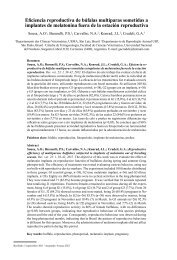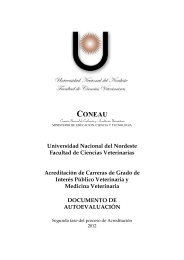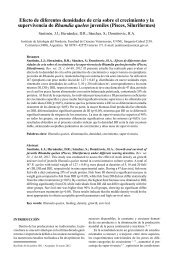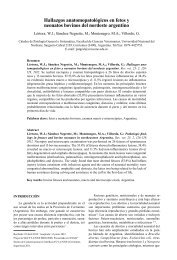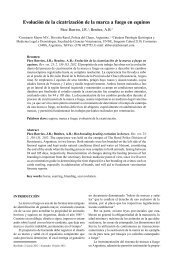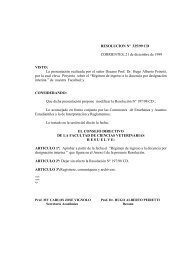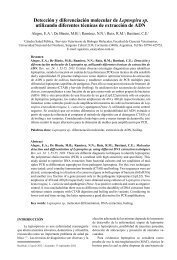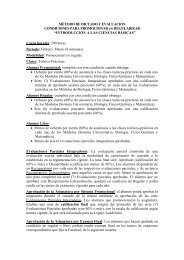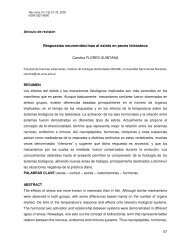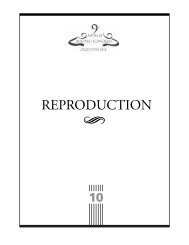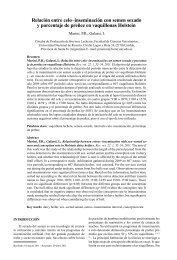MILK PRODUCTION
MILK PRODUCTION
MILK PRODUCTION
Create successful ePaper yourself
Turn your PDF publications into a flip-book with our unique Google optimized e-Paper software.
538<br />
<strong>MILK</strong> <strong>PRODUCTION</strong><br />
Buffaloes milk physicochemical properties<br />
raised on tropical pasture<br />
Oliveira, J.S.; Souza, A.O.; Fernandes, S. A. A. * ; Ferrão, S.P.B.; Silveira, E.S.<br />
Southwest of Bahia University, Praça Primavera 40, Primavera, Itapetinga, Bahia, Brazil. E-mail: fernandes_pe@hotmail.com<br />
Abstract<br />
The main objective of present investigation was to study the effect of lactation stage and animal’s breed on physicochemical<br />
properties of milk from buffalo. The experiment was carried out from May to September, 2008, in the Três Irmãos<br />
farm, located in the Maiquinique (Bahia, Brazil).The follow physicochemical parameters were determined: total acidity<br />
and pH, density, cryoscopy, which indicated that there was not interaction between breed and lactation stage.<br />
INTRODUCTION<br />
Key words: Buffalo Milk, Lactation Stage, Physicochemical Characteristics.<br />
The importance of food science and technology for improving the human beings quality of life is highlighted by the<br />
rising search for healthy food, with high nutritional value, available and accessible to people. With this, the investigation<br />
of alternative food sources has been the subject of extensive researches in the last decades. Buffalo’s milk is<br />
promising in this context, since it has a superior nutritional value due to the high levels of fat, protein and minerals<br />
(specially calcium and phosphorus), that can be consumed in natura and may be used as raw material for producing diary<br />
products, varying in accordance to each regional culture 1, 2 savu . Moreover, buffalos are extremely rustic and demonstrate a<br />
high adaptation capacity, being able to survive in diverse environments with huge weather variations, relief and vegetation,<br />
so growing them is very economically feasible 4-3,5-4 . The data found regarding buffalo’s milk characteristics are very<br />
varied, since several factors influence the physicochemical properties 6, 5-8, 6 . In this context, the aim of this work was to<br />
evaluate the quality of milk from buffalo herd raised in the Bahia southwest, concerning physicochemical characteristics,<br />
as well as factors that influence, such as the lactation stage and the animal’s breed.<br />
MATERIALS AND METHODS<br />
The experiment was carried out from May to September, 2008, in the Três Irmãos farm, located in the Maiquinique (Bahia,<br />
Brazil). Twenty four animals were separated, according to extern characteristics, 12 were of the Murrah breed and 12 of<br />
the Jafarabadi breed. Animal’s food was pasture with Brachiaria Decumbens, with mineral salt supplement available.<br />
Buffalos of the same race were subdivided in three groups, four animals each. One liter of milk was sampled from every<br />
animal. Samples from animals of the same group were mixed, forming a composed sample. Thus, the composed samples<br />
were collected during the lactation, at the beginning (approximately one month after lactation), in the middle (fifth<br />
month of lactation) and at the end (near the ninth month of lactation).The follow physicochemical parameters were<br />
determined: total acidity and pH, density and cryoscopy. For statistical analysis, the results obtained were treated using<br />
Proceedings 9 th World Buffalo Congress



